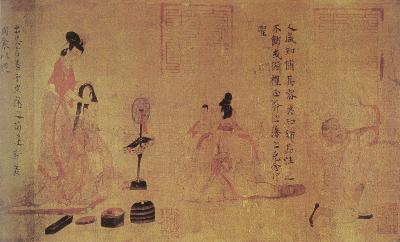
Scroll painting is a kind of artistic work by painting on paper or silk. From the Warring States Period (475-221BC) to the period before the Opium War (1644-1840) in the Qing Dynasty, Chinese painting had come a long way during the 2,000 years, and its style had also experienced many changes. Characters inHuman Reining DragonandDragon,Phoenixand Beauties,silk paintings of theChuStatein the Warring States Period, are very vivid. Though they are not scroll paintings in the real sense, the high artistic level of that period is still appreciable. In the silk paintings and Daoyin Tu unearthed in the Mawangdui Han (206BC-220AD) tombs, people can read from their elegant composition that paintings of that period had reached a very high level. The Three Kingdoms Period (220-280), the Jin Dynasty (265-420) and the Southern and Northern Dynasties (386-589) are very important periods of Chinese painting history. Although there were wars and many dynastic changes during this period, active intellectual life of different schools provided a great impetus to artistic development. Well-known grotto murals, tomb paintings, stone carvings, brick carvings and lacquer paintings were produced during that period, and a number of virtuosos emerged in Chinese calligraphy and painting. Gu Kaizhi, known as the founder of traditional Chinese painting, and his scroll paintings, represented the painting style of the period. Gu also made great contribution in summarizing painting theories. His theoretical works includedPainting ThesisandNotes on Painting the Yuntai Mountain. HisGraphic Theorylater became a basic theory for traditional Chinese painting. According to historical records, Gu created more than 70 paintings based on historical stories, Buddha, human figures, birds, animals, mountains and rivers. His three existing scroll paintings areNvshi Zhen Painting,Luoshen Appraisal PaintingandLienv Renzhi Painting,which are the earliest examples of scroll paintings.

In the Sui and Tang Dynasties (581-907) Chinese painting reached a peak. Although fresco was still the mainstream with praiseworthy works, scroll painting was rising. Because it was easy to carry and enjoy, it quickly became popular. Paintings in the Tang Dynasty gained all-around development. The painting saga Wu Daozi made great contribution to figure painting and landscape painting.Five Cattle Pictureby Hanhuang of the Tang Dynasty represents the high level of horse-and-cattle paintings then. In Five Dynasties (907-960), scroll painting changed its style. InNorth China, Jin Hao and Guan Tong founded magnificent and enchanting full-view landscape painting. InSouth China,JiangnanSchool, represented by Dong Yuan and Ju Ran, were good at exhibiting peaceful and natural scenery of Jiangnan area (south of the lower reaches of theYangtze River). This style became popular in the late Yuan Dynasty (1279-1368), and exerted a significant influence to the development of Chinese painting. Scroll painting was the main form of Chinese painting in the Yuan, Ming and Qing Dynasties, stressing the technique of using ink. Zhao Mengfu and the Four Great Masters of the Yuan Dynasty put the theory into practice. Their artistic achievement promoted the development of Chinese painting and played a decisive role to the formation of theory as well as practice at that time. Many schools of Chinese painting emerged in the Ming Dynasty (1368-1644), each with their own systematic theory. The school ofliterary-freehand-brushwork landscape painting (wenren xieyi shuimo hua)represented byWumenSchoolbecame a new trend. Its landscape painting focused on emotional appeal and quiet elegance, while its flower-and-bird painting focused on innovation and variation, which had great influence on later generations. The theory of Scholar Painting (wenren hua) proposed by Dong Qichang in later period of the Ming Dynasty had far-reaching repercussions to the style of landscape painting in the Qing Dynasty. Having inherited the tradition of the Yuan and Ming Dynasties, the Scholar Painting became the mainstream gradually. Landscape painting and freehand-brushwork wash painting (shuimo xieyi hua) were popular. Influenced by Scholar Painting, more and more painters began to pursue the emotional appeal of painting. The Four Kings in the early Qing Dynasty became the orthodox school because of the high regard from royalty, and they stressed on force and skill. At the same time, the Four Monks andJinglingSchoolled by Gong Xian also had great influence in Jiangnan area. Proposing to express the individuality, their style was novel and special. The rising ofYangzhouSchoolin the early Qing Dynasty was like the coming out of revolution. They preferred plum flowers, orchid, bamboo and chrysanthemum as subjects and the technique of splashed-ink. They had profound influence on the flower-and-bird painting of the modern times.
Chinese ancient painting was of long history and unique style. After thousands of years' changes and improvement, it has rich ethical style and distinctive character of the times. There are not many scroll paintings left for us to recall the traditional culture.










